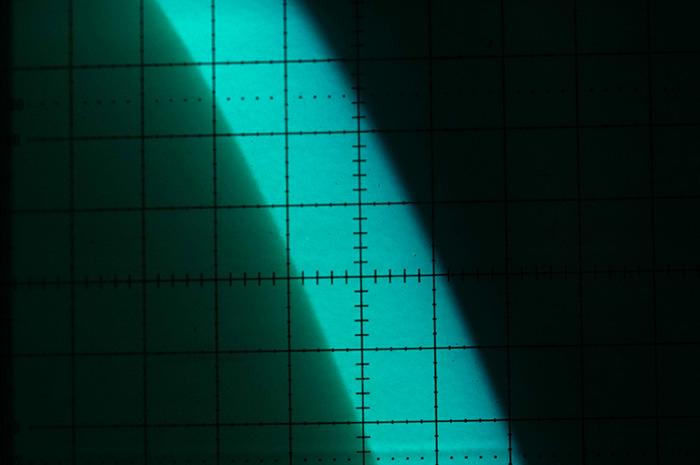This is part of a long series of posts about the Sony a6300. The series starts here.
The Sony a6300 has a silent shutter mode. When running silent, the mechanical shutter is on vacation, lying back and catching Z’s while the sensor does all the work. The mechanical shutter is a rabbit, completing an exposure in 1/200 second (for shutter speeds faster than that, a slit moves across the sensor, but it takes the slit a little under those 4 milliseconds to make its journey. The fully electronic shutter is a tortoise, taking longer to do its job.
How much longer? Stay tuned.
I set up an analog oscilloscope with an input from a function generator. If you’re going to try this at home, don’t try it with a digital scope; it won’t work. I set the time base to 1 msec/division, and the amplitude of the generator to just over the maximum excursion for the scope’s vertical sensitivity. I mounted a 80mm f/2.8 Sony G Macro lens on the a6300. I put the RRS plate on the camera and clipped it into a Gitzo tripod. I set the camera for electronic first curtain shutter, with silent shutter off. I set the camera to manual exposure, and the shutter speed to 1/500 second – that’s two msec. I stopped down a bit and cranked up the ISO to 1000.
I took a picture:
You can see that the trace is about two divisions wide. One division is 1 msec, and we set the shutter to 2 msec, and twice one is two. Isn’t it nice how that worked out? Now notice that the bright part of the image is not vertically oriented, as it would be if every part of the image was exposed in the same 1/500 second. It’s diagonal. Since scope traces from left to right, the fact that the top of the diagonal is left of the bottom means that the shutter exposed the top of the image before it exposed the bottom. Since the image is upside down on the sensor, that means that the a6300’s mechanical shutter must move from the bottom of the camera to the top.
Also note that the lines are slightly curved, indicating that the trailing curtain increases its speed as it moves across the image plane, and the electronic leading curtain performs an approximation of that behavior, even though its inertia is presumably zero.
We can also look at the picture and tell how long the shutter took to go from the bottom of the camera to the top. We can see that it takes the shutter a little over three divisions to go from the bottom of the camera to the top. That’s 3 plus msec, and the synch speed is 1/160 second, or 6 msec. Looks like the Sony engineers put a more than the usual amount of wiggle room in there.
Now, let’s change the time base to 5 milliseconds per division (5msec/div), and take another picture:
Makes the mechanical shutter look pretty fast, doesn’t it? Leaving the time base and the exposure time the same, what happens when we turn on the silent shutter?
A lot slower. How fast is it? About 9 or 10 divisions, or 45 or 50 msec. The silent shutter takes a hair less than 1/20 of a second to complete its travel across the sensor. That’s slower than the a7S’s 1/30 second, but faster than the a7RII’s 1/14 second.
Here’s a way to look at the readout speeds of the three cameras:
On a pixel per second basis, the cameras get faster as the resolution goes up. On a row per second basis, they get slower.
I thought the silent shutter on the a7S was marginal for moving subjects, and the a7RII close to unusable. The a6300 is in between (about halfway in between if you think in logarithms). I expect that it will find some use, but you should be careful when your subject (or the camera) moves, or you many see some distortions.
All three cameras have slow enough silent shutters that banding may occur with fluorescent, neon, or LED light sources that vary their output light at line frequency or double line frequency.




Outstanding research and results. Thank you!
If the A7RII is switched onto APS-C crop mode, does it become faster?
It becomes the same as the a6300:.
http://blog.kasson.com/the-last-word/sony-a7rii-silent-shutter-speed-in-aps-c-mode/
http://blog.kasson.com/the-last-word/sony-a6300-silent-shutter-transit-times-compared-to-other-sony-cameras/
Yeah, I had this proved to me the hard way when I went from an A7s to an A7r II.
Street photography on the move in silent mode was possible with the A7s but grotesque on the A7r II 🙁
The A6300 can’t really handle it either, so now I don’t use it.
It also drops to 12-bit, so that’s another consideration…